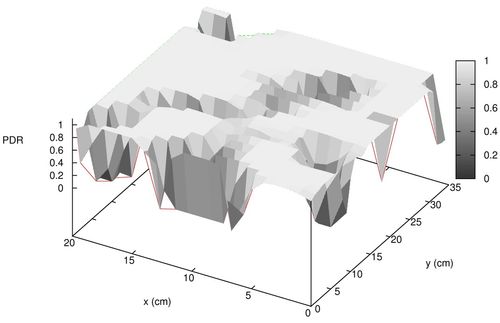...
Connectivity traces were collected by J. Ortiz and D. Culler in a UC Berkeley office space (traces are made available at http://wsn.eecs.berkeley.edu/connectivity/). 46 IEEE802.15.4-compliant TelosB motes are deployed in a 50m by 50m indoor environment, and are constantly listening for packets. One after the other, each mote transmits a burst of 100 packets, with a 20ms inter-packet time and a transmission power of 0dBm, on each of the 16 frequency channels which span the 2.4-2.485GHz band. Timers are used to ensure that all nodes switch channels simultaneously. Note that, because bursts are sent in sequence, there are no collisions. All non-transmitting nodes record the timestamp of the packets received, their source address, and the frequency channel the packets are received on. After all 46 nodes have sent a burst, each node reports what packets it has received. This process is repeated in 17 runs. A single run completes in 13 minutes; several hours separate subsequent runs.
With these traces in hand, one can plot the reliability of a link depending on its frequency. Reliability can be simply expressed as the Packet Delivery Ratio (PDR): the ratio between the number of received packets and the number of sent packets. A PDR of 1 indicates a perfect link. The figure below plots the average reliability of all links, depending on their frequency. While at some frequencies (e.g. channel 26, or 2.480GHz) PDR is around 87%, it drops to close to 75% at others (e.g. channel 12, 2.415GHz). This is due to IEEE802.11 (!WiFi) activity on IEEE802.11 channels 1, 6 and 11.
...
The figure below depicts the resulting 3D plot of PDR versus transmitter location, when transmitter and receiver are separated by (only) 1m. While on most locations connectivity is good with PDR hovering around 100%, in locations just centimeters away, PDR drops to 0%.
Because multi-path fading depends entirely on the environment, it cannot be predicted without infinite knowledge of the object's location, orientation and reflective characteristics. When adding the fact that people walk around, and doors are opened and closed, predicting the location of the deep fades (the location where PDR reaches 0%) is infeasible.
...
During a timeslot, one node typically sends a frame, and another sends back an acknowledgement if it successfully receives that frame. If an acknowledgement is not received within the timeout period, retransmission of the frame waits until the next assigned transmit timeslot (in any active slotframe) to that address occurs.
As shown above, the timeslot starts at time T=0 from the transmitting device's perspective (lower part). The transmitter waits TsTxOffset us, then begins transmitting the packet. The transmitter then waits TsRxAckDelay us, then goes into receive mode to await the acknowledgment. If the acknowledgment does not arrive within TsAckWaitTime us the device may idle the radio and that no acknowledgment will arrive. From the beginning of the slot, the receiver (upper part) waits TsRxOffset us, then switches on its radio. It stays on for a maximum of TsPacketWaitTime us, or until receiving a packet. After receiving a packet, it wait for TsTxAckDelay us, and replies with an acknowledgement.
...





